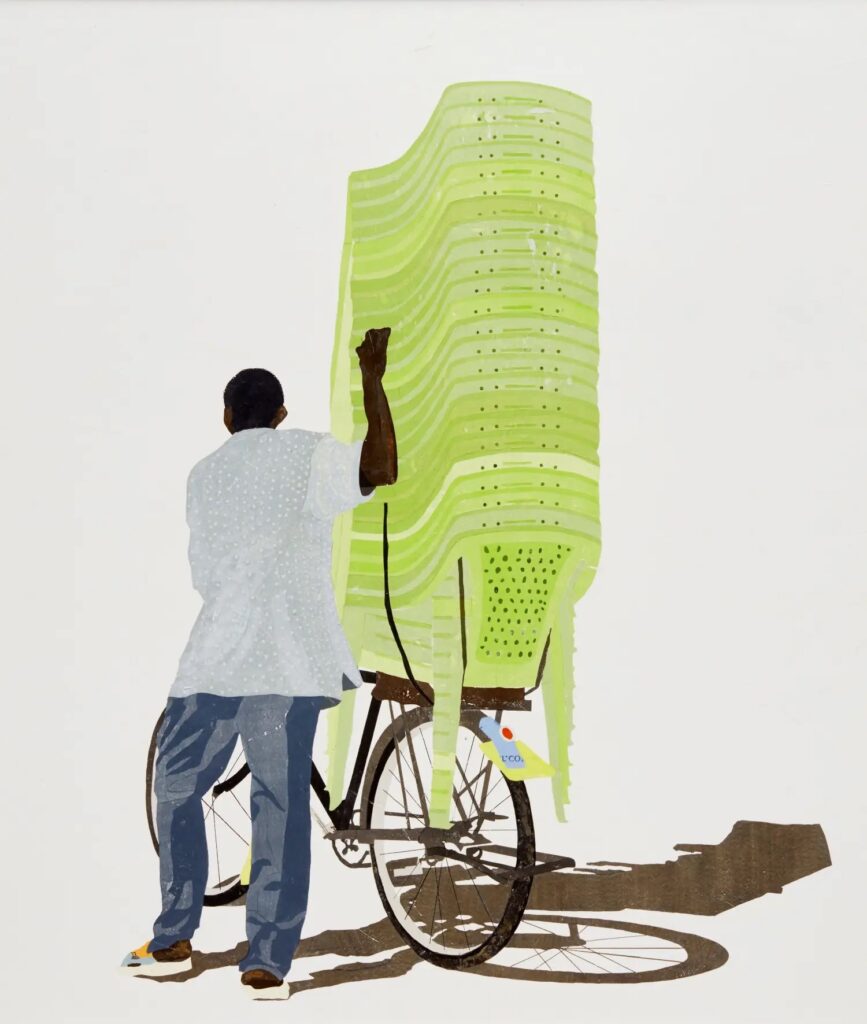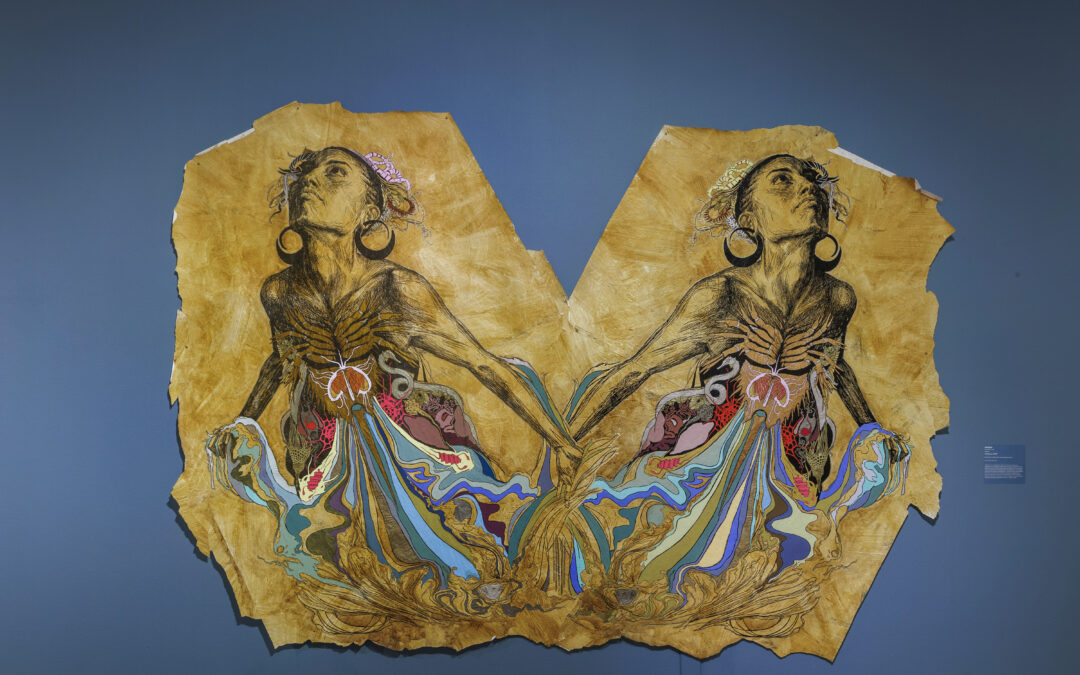(Swoon, Thalassa, 2012. Screenprint, coffee stain, hand painting on paper, 120 x 84 in. Collection of the Waldo Family. Photo by Echard Wheeler)
By Betsy DiJulio
With Collector’s Edition, MOCA set out to craft a colorful, summery, and celebratory exhibition. But what resulted is so much more.
Throughout last spring and early summer, Kara Walker: Cut to the Quick filled the galleries with painful and powerful black and white imagery—and all the concomitant gray area that comes with explorations of slavery and colonialism—so the museum was very intentional about the pendulum swing.
That is not to say that Collector’s Edition is in any way lightweight. Yes, the walls have been sun kissed the colors of saltwater taffy and the galleries infused with a kind of joie de vivre, as opposed to sexual trauma, oppression, racism, and resilience. But visitors can find whatever they might have come looking for, be it specific subjects—including heavy-hitters like immigration and our fragile environment—styles, media, or artists—over 70 of them—from international art stars to local and regional luminaries.
Collector’s Edition began as the germ of an idea from Vince Mastracco who, along with his wife Suzanne, is a longtime and avid collector and benefactor of the arts in our region. Many conversations, connections, and cast nets later, this show of work generously loaned by 23 Hampton Roads-based collectors—some who do not even consider themselves “collectors”—took shape under the direction of co-curators, Alison Byrne, who is also deputy director of exhibitions and education, and Heather Hakimzadeh, senior curator and special projects manager.
Their curatorial approach was steeped in diversity and democracy. In search of those who support artists and creative culture, if someone prioritizes art in their life and chooses to live surrounded by that art, they were fair game. Whether these individuals accept the appellation “art collector” or not was irrelevant. Ditto whether, if they happened to be an artist themself, they traded art rather than cash for their acquisitions.
From a show this diverse, choosing pieces to explore in depth would be tantamount to choosing a favorite dog, i.e. impossible. But exploring the notion of “collecting” is, as it turns out, just as rich, deep, and complex. What is the difference between accumulating works of art—in some cases from floor to ceiling—and “collecting”? Is there a difference? Is it just semantics? Does it matter?
If we look to the art world with a capital “A,” many who dwell there assert that there is a difference, with those who consider themselves bonafide collectors often viewing the art holdings of others they deem non-collectors as more of an “assemblage.” Collectors, some would say, are authorities or knowledgeable experts who research and amass pieces of art, often with a theme or by the same artist, in a way that increases or advances our understanding of the art, perhaps even identifying or establishing trends. Guiding this endeavor is a kind of purposeful, long-range commitment as opposed to a more or less random response to one’s likes, attractions, and preferences.

(Hugo McCloud, take a seat, 2020. Single use plastic mounted on panel, 70 x 60 in. © Hugo McCloud. Photo by Jason Wyche, New York. Courtesy of Sean Kelly. Collection of Meredith and Brother Rutter)
But the line is fuzzy—do we even need a line?—and the reasons people collect—or acquire and amass—are many and revealing. Meredith Rutter jokes that while some couples play golf, she and her husband, Brother—buy art. Well-known as serious collectors of contemporary art, the pursuit is a passion for both of them and one around which they have woven travel, research, lifelong learning, deep connections, and lasting relationships.
Robert S. Hewitt, Jr., sees art as a repository for an artist’s ideas and thoughts. It is the human connections forged by investing in artists and sharing their work with others that inspire him. Lelia Graham Webb and her husband Randy collect art as a “partnership” that started during their courtship in Paris. Eschewing the rubric “collectors,” they have never looked back, only deeply into the narratives embodied in the photographs they collect. Plastic surgeon, Matthew Galumbeck, and his family are drawn to collecting contemporary art for the intellectual and cultural stimulation. Examining, engaging, reflecting, and challenging are all part of their process.
My cousin Earl Weed, is a retired attorney and fairly serious collector of art in Houston, TX. Over the years, I have been engaged from the sidelines as he has bought and sold art, focusing on specific artists, movements, and genres. When asked to weigh-in about collecting art, he shared that he has been studying the questions that arise for years, acknowledging that they have “multitudinous answers,” yet remain somewhat of a mystery.
In his words, a “real collector is obsessed.” For him, collecting is about “trying to solve some kind of problem…trying to comprehend that language.” But each “picture,” as he calls his paintings, prints, and photographs, “is somewhere to go into. An adventure.” When he collects multiple works by individual artists, his rationale is the opportunity to experience “different aspects of how that artist sees and speaks.” He concludes, “And it’s, frankly, like an addiction…Someone who buys enough art for the walls and then stops is kind of strange—to me.”
There is no better place than MOCA this summer and fall to contemplate these questions, revel in these mysteries, indulge your curiosity, feed your mild obsession, or give in to your—or others’—addiction.
WANT TO SEE?
Collector’s Edition
Through December 31
Virginia Museum of Contemporary Art (MOCA)




